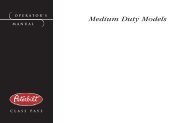Peterbilt Model 320 Operator's Manual after 8-07 - Peterbilt Motors ...
Peterbilt Model 320 Operator's Manual after 8-07 - Peterbilt Motors ...
Peterbilt Model 320 Operator's Manual after 8-07 - Peterbilt Motors ...
You also want an ePaper? Increase the reach of your titles
YUMPU automatically turns print PDFs into web optimized ePapers that Google loves.
PART 5: SEAT AND RESTRAINT SYSTEMS<br />
Inspection of the Restraint System<br />
WARNING! Failure to properly inspect and<br />
maintain restraint systems can lead to serious<br />
injury or loss of life. Without periodic<br />
inspection and maintenance to detect unsafe<br />
conditions, seat restraint components can wear<br />
out or not protect you in an accident.<br />
The typical three-point seat systems in passenger cars may<br />
seem very similar to the three-point seat belt system in<br />
heavy duty vehicles, but there are some key differences<br />
that all users of this system should be aware of:<br />
• In typical passenger vehicle automotive seat belt applications,<br />
the normal life of the vehicles is usually 8<br />
to 10 years and the total mileage frequently does not<br />
exceed 125,000 miles (200,000 km). Heavy duty vehicles<br />
often see this type of mileage in a very short<br />
period of time, and accumulation of mileage in excess<br />
of 500,000 miles (800,000 km) during the vehicle lifetime<br />
is not unusual.<br />
• A significant difference in the two systems is the<br />
amount of movement of webbing in the system. In<br />
an automotive application, there is little movement of<br />
the seat belt system, except when the user puts on or<br />
Inspection of the Restraint System<br />
takes off the belt. In trucks, however, there is almost<br />
constant movement of the belt through hardware due<br />
to ride characteristics and seats which are designed<br />
to move, in order to enhance driver comfort. There<br />
can even be movement of the webbing in the seat<br />
belt system when the belt in not being used. Relative<br />
movement between the seat and the cab, which normally<br />
occurs whenever the truck is in operation, can<br />
cause wear of the seat belt webbing.<br />
• Environmental conditions represent another major difference<br />
in the systems in automobiles and heavy duty<br />
and specialty vehicles. Unlike the automotive environment,<br />
heavy duty and specialty vehicles may be very<br />
dirty, and have more exposure to the sun’s damaging<br />
ultraviolet rays, thus resulting in a reduction of the life<br />
of the seat belt system.<br />
The high mileage associated with heavy duty vehicles and<br />
possible wear of the 3-point seat belt system, the continual<br />
relative movement of the system, the possible contact with<br />
the vehicle seat or other parts of the cab structure, and the<br />
potential exposure of this system to severe environmental<br />
conditions make it crucial to inspect the three-point seat<br />
belt systems regularly. It is recommended that the seat<br />
belt system in a vehicle be inspected every 20,000 miles<br />
(32,000 km) or more often if the vehicle is exposed to severe<br />
environmental conditions. Any seat belt system that<br />
R(08/<strong>07</strong>) Y53-6015 – 65 –
















